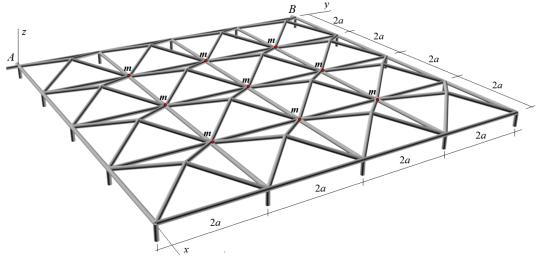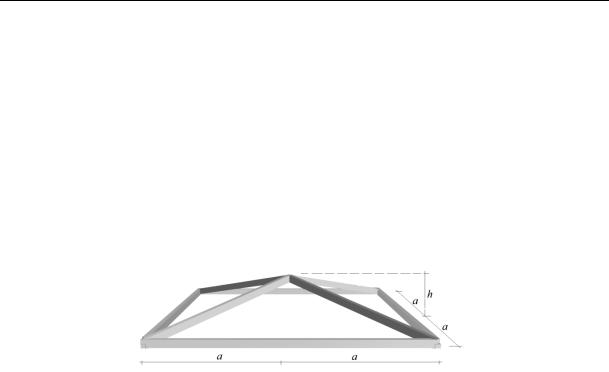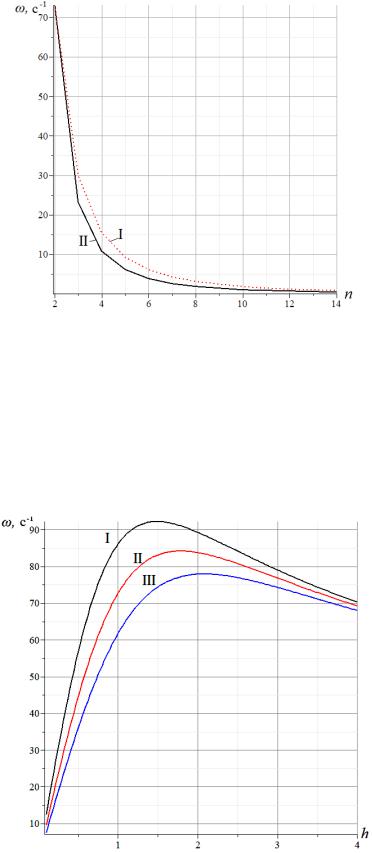
3677
.pdf
Russian Journal of Building Construction and Architecture
2. In compliance with the risk-oriented approach to the production of safe products, based on the requirements of the law №184 "On Technical Regulation", this solution should be made as justified in relation to the required surfacing width.
4. Improving the cross-section of the existing six-lane road (based on the assessment and reduction of the risk of accidents to a permissible value in the process of maneuvering ahead of high-speed vehicles on low-speed vehicles on the multi-lane carriageway). The risk of interaction of vehicles on the existing six-lane highway where there might be an accident ahead of the change of lane is given by formula (1). In this case, its designations are as follows:
ВПР = ВСР is the average actual surfacing width (reinforced surface) in one direction of
movement, including the width of the three-lane carriageway and the width of the reinforced lanes on the right sidewalk and the central dividing strip. (At independent tracing of counter lanes the parameter ВСР includes the width of the strengthened lanes on both roadsides), m; The value ВСРis determined in the process of surveying the surfacing width by means of the
formulas of statistical analysis. |
|
|
|
|
|||||
ПР |
|
СР |
|
= 12.71( |
) |
Ф |
|
|
|
In this case ВСР |
|
; |
|
|
|
|
|||
доп |
|
|
which is the actual standard deviation ( |
|
) of the surfacing width in one direc- |
||||
|
|
|
|
||||||
tion |
of movement is identified during the in-house processing of the measured surfacing |
||||||||
= |
|
|
|
|
|
|
Ф = 0.37( |
|
|
width by means of the statistical analysis methods. In our example, let |
; |
||||||||
Input parameters: |
|
|
|
) |
|||||
Vehicle speeds:
––car (GAZ 3110 "Volga"), as already noted, is moving at a calculated speed for this category of six-lane road (V1 = Vp = 120 km/h = 33.33 m/sec);
––intercity bus Setra S411 maneuvres at the speed 80 km/h = 22.22 m/sec;
––road train moving at the speed 70 km/h = 19.44 m/sec along the width of the traffic lane of 3.75 m.
While driving on the inner lane of the car with the calculated speed, the risk ofthe large vehicle Setra S411 overtaking the intercity bus on the actual (operated) surfacing width according to the following procedure.
1. The critical surfacing width where 50 % of road accident occur is given by dependence (2)
ВКР |
|
4.921×33.33 |
1.8+1.5 |
|
(10.465+3.6) ×22.22 |
|||||
|
= |
200 |
+ |
2 |
|
+ |
|
200 |
|
+2.55+ |
|
|
16.5×19.44 |
2.04+2.15 |
= 10.28 ( |
). |
|
||||
|
|
+ |
200 |
+ |
|
|
2 |
|
||
100

Issue № 3 (51), 2021 |
ISSN 2542-0526 |
2.The standard deviation of the critical width of the coating is given by the expression (3)
КР |
= |
|
(4.921×33.33) +(10.465+3.6) ×27.7 + (16.5×19.44) |
= 0.79( ). |
|
|
600 |
3. The risk of an accident on an existing six-lane motorway while a low-speed vehicle is being overtaken by a high-speed vehicle (Setra S411 intercity bus) is given by formula (1).
ДУ |
= 0.5 − |
Ф |
|
|
доп − |
ВКР |
|
= 0.5− |
Ф |
|
12.71−10.28 |
= 0.00281. |
|
. . |
|
|
|
ВПР |
|
|
|
|
|
||||
|
|
|
|
|
|
|
0.37 +0.79 |
||||||
|
|
ВПР |
+ |
ВКР |
|
|
|||||||
|
|
|
|
|
|
|
|
|
|
||||
Conclusions:
1.According to the resulting risk, 28 cars out of 10.000 (or 3 cars out of 1.000) in a six-lane highway in one direction will be involved in the collision due to the insufficient width of the surfacing and the low quality of its construction.
2.The permissible risk on the existing roads built before the application of Federal Law
3. Let us look at the increase in the |
1×10 |
. |
№184 "On Technical Regulation" is |
|
surfacing width in one direction of movement to 12.81 m,
and reducing the standard deviation of this width to 0.20 m. Based on this solution according to formula (1), the risk of an accident for the above composition of traffic importance on the existing roads is 1×10 :
ДУ |
= 0.5 − |
Ф |
|
|
доп − |
ВКР |
|
= 0.5− |
Ф |
|
12.81−10.28 |
= 0.00102. |
|
. . |
|
|
|
ВПР |
|
|
|
|
|
||||
|
|
|
|
|
|
|
0.20 +0.79 |
||||||
|
|
ВПР |
+ |
ВКР |
|
|
|||||||
|
|
|
|
|
|
|
|
|
|
||||
Thus while improving the cross-section of the existing multi-lane road, the average surfacing width should be at least 12.81 m, and the standard deviation of the surfacing width should not exceed 0.20 m.
Conclusions:
1.The technique of normalizing the surfacing width of a multilane road (for the development of GOST (ГОСТ) and SP (СП) or for checking the conformity of the normalized parameters to the required ones) based on calculating and reducing the risk of collision of vehicles on a six-lane road to an admissible level of risk is shown;
2.Mathematical models and methods of design of the surfacing width based on the compliance with an acceptable or admissible risk of collision of vehicles during overtaking with a change of lanes (at any parameters of vehicles on a multilane carriageway) have been developed;
101

Russian Journal of Building Construction and Architecture
3. The algorithm is presented for improving the parameters of cross profiles of the existing multilane roads based on the estimation and reduction of risks of road accidents to a permissible value in the course of maneuvering when slow-moving vehicles are being overtaken by high-speed cars on a multilane carriageway.
References
1.Vetrogon A. A., Kripak M. N. Transportnoe modelirovanie kak instrument dlya effektivnogo resheniya zadach v oblasti upravleniya transportnymi potokami [Transport modeling as a tool for effective solution of problems in the field of traffic flow management]. Sovremennye tekhnologii. Sistemnyi analiz. Modelirovanie, 2018, no. 3 (59), pp. 82––91.
2.Granovskii V. A., Odintsov A. E. Metody sbora i obrabotki informatsii transportnykh potokov[Methods of collecting and processing information oftransport flows]. Avtomobil'naya promyshlennost', 2015, no. 2, pp. 25––26.
3.Danilkin V. A., Trukhachev A. A., Beltov A. G. Postroenie modeli perestroeniya transportnym sredstv v transportnykh potokakh [Construction of a model of rebuilding vehicles in transport flows]. Programmnaya inzheneriya, 2012, no. 6, pp. 30––34.
4.Starozhilets V. M., Chekhovich Yu. V. Ob identifikatsii statisticheskoi modeli transportnykh potokov s ispol'zovaniem grupp avtomobil'no-transportnykh sredstv [On the identification of a statistical model of transport flows using groups ofmotor vehicles]. Mashinnoe obuchenie i analiz dannykh, 2017, vol. 3, pp. 193––202.
5.Stolyarov V. V., Shchegoleva N. V. Opredelenie dopustimykh srednekvadraticheskikh otklonenii geometricheskikh parametrov avtomobil'nykh dorog [Determination of permissible standard deviations of geometric parameters of highways]. Dorogi i mosty, 2018, vol. 38, p. 5.
6.Stolyarov V. V. Proektirovanie avtomobil'nykh dorog po usloviyu obespecheniya bezopasnosti dvizheniya s ispol'zovaniem teorii riska. Diss. d-ra tekhn. nauk [Designing highways according to the condition of ensuring traffic safetyusing the theoryof risk. Cand. eng. sci. diss.]. Saratov-Moscow, 1995. 337 p.
7.Stolyarov V. V. Proektirovanie avtomobil'nykh dorog s uchetom teorii riska : v 2 ch. [Designing highways taking into account the theoryof risk. Part 1]. Saratov, Sarat. gos. tekhn. un-t Publ., 1994. 184 p.
8.Stolyarov V. V. Dorozhnye usloviya i organizatsiya dvizheniya s ispol'zovaniem teorii riska [Road conditions and traffic organization using the theoryof risk]. Saratov, SGTU Publ., 1999. 168 p.
9.Stolyarov V. V., Gusev V. A., Shchegoleva N. V. [Speed limit according to the permissible risk for ensuring traffic safety on difficult sections of highways]. Sb. tr. uchastnikov 11-i mezhdunar. nauch.-prakt. konf. “Organizatsiya i bezopasnost' dorozhnogo dvizheniya v krupnykh gorodakh” [Proc. “Organization and safety of road traffic in large cities”]. Saint-Petersburg, 2014, pp. 369––379.
10.Stolyarov V. V., Shchegoleva N. V., Kokodeeva N. E., Kochetkov A. V. Primery rascheta geometricheskikh, transportno-ekspluatatsionnykh i prochnostnykh parametrov avtomobil'nykh dorog na osnove teorii riska. Ch. I. Proektirovanie [Examples of calculating geometric, transport-operational and strength parameters of highways based on the risk theory. Part I. Design]. Saratov, Sarat. gos. tekhn. un-t Publ., 2017. 272 p.
11.Teben'kov S. E., Levashev A. G. Rezul'taty otsenki raspredeleniya transportnykh potokov v transportnykh koridorakh [Results of the assessment of the distribution of transport flows in transport corridors]. Vestnik
102
Issue № 3 (51), 2021 |
ISSN 2542-0526 |
Irkutskogo gosudarstvennogo tekhnicheskogo universiteta, 2011, no. 10 (57), pp. 120––127.
12.Torobekov B. T., Okhotnikov V. I. Razvitie transportnoi logisticheskoi sistemy putem monitoringa transportnogo potoka [Development of the transport logistics system by monitoring the transport flow]. Izvestiya Kyrgyzskogo gosudarstvennogo tekhnicheskogo universiteta im. I. Razzakova, 2017, no. 4 (44), pp. 428––433.
13.Tekhnicheskie kharakteristiki avtomobilei [Technical characteristics of cars]. Available at: http://avtomarket.ru/catalog/
14.Ishihara Y., Sugawara T. Analysis of Traffic Congestion Reducer Agents on Multi-Lane Highway. Proceedings –– 2019 2nd International Conference on Intelligent Autonomous Systems, ICoIAS 2019, 2019, pp. 135––141.
15.Jiao X., Yang D., Jiang K., Wen T., Yan R. Real-time lane detection and tracking for autonomous vehicle applications. Proceedings of the Institution of Mechanical Engineers, Part D. Journal of Automobile Engineering, 2019, no. 233 (9), pp. 2301––2311.
16.Mandžuka S. Lecture Notes in Networks and Systems. Intelligent Mobility, 2020, pp. 367––376.
17.Mestri R. A., Garg R. D. Identification and Removal of Accident-Prone Locations Using Spatial Data Mining. Lecture Notes in Civil Engineering, 2020, pp. 383––394.
18.Shin H.-S., Turchi D., He S., Tsourdos A. Behavior Monitoring Using Learning Techniques and Regular-
Expressions-Based Pattern Matching. IEEE Transactions on Intelligent Transportation Systems, 2019, no. 20 (4),
pp. 1289––1302.
19.Song D., Tharmarasa R., Florea M. C., Fernando X. N., Kirubarajan T. Multi-vehicle tracking with microscopic traffic flow model-based particle filtering. Automatica 105, 2019, pp. 28––35.
20.Szczuraszek T., Klusek R. Influence on the Type of Intersection on Road Traffic Safety in Poland. IOP Conference Series: Materials Science and Engineering, 2019, no. 471 (6), pp. 75––83.
103

Russian Journal of Building Construction and Architecture
BUILDING MECHANICS
DOI 10.36622/VSTU.2021.51.3.009
UDC624.04:531.391.3
M. N. Kirsanov1
SPECTRUM OF OWN FREQUENCIES OF A SPATIAL SURFACING GIRDER*
«MEI» National Research University1
Russia, Moscow
1D. Sc. in Physics and Mathematics, Prof. of the Dept. of Robotics, Mechatronics, Dynamics and Strength of Machines, tel.: +7 (495) 362-73-14; e-mail: c216@ya.ru
Statement of the problem. The scheme of a staticallydefinable girder of a spatial rectangular surfacing is discussed. The problem is to identify the formula for the dependence of the lower estimate of the first frequency of the natural oscillations of the structure by means of the Donkerley method on the number of panels. The truss has supports on the sides and consists of separate rod cells connected in pyramids.
Results. Based on the analysis of the sequence of analytical solutions for the first frequency of girders with a different number of panels by induction, the coefficients in the desired formula are derived. The common members of the sequences of coefficients are found as solutions of homogeneous recurrent equations formed according to the results of the calculations using Maple operators. The resulting dependences are obtained in the form of polynomials by the number of panels. A comparison of the analytical solution with the numerical one is provided.
Conclusions. An algorithm for deriving an analytical estimate of the fundamental frequency of oscillations of a spatial structure depending on the number of panels, mass, size, and elastic properties of the material is shown. The spectrum of oscillation frequencies of the structure is analyzed. The resulting dependences can be employed in seismic and structural optimization problems.
Keywords: spatial girder, natural frequency, Donkerleymethod, lower estimate, induction, Maple, analytical solution, natural frequencyspectrum, multiple frequencies.
Introduction. The calculation of the frequencies of natural vibrations of building structures in practice is commonly performed in standard packages by means of the finite element method [4––6, 22]. The values of natural frequencies are crucial in analyzing the seismic resistance of structures[11, 20, 21] and under operating conditionsunder externaldynamic influences[16, 18].
* The research is funded by the Interdisciplinary Scientific and Educational School of Moscow University "Fundamental andApplied Space Research".
© Kirsanov М. N., 2021
104

Issue № 3 (51), 2021 |
ISSN 2542-0526 |
An alternative to numerical methods for calculating the vibration frequency spectra of structures is the analytical method. What makes the study timely and relevant is that for systems with a large number of degrees of freedom, it is generally impossible to obtain an exact solution to the problem of identifying the natural frequencies in the general case. An exception is the approximate solution of the problem of the lower estimate of the first frequency using the Donkerley method [14]. Among the known solutions, it is possible to single out those for regular (periodic) statically definable rod systems.
R. G. Hutchinson and N. A. Fleck [8, 9] looked at the problem of regular bar structures. There are known analytical solutions for deflection of flat trusses depending on the number of panels [1––3, 10, 17, 19, 23––26] obtained by means of the induction method in the Maple mathematical software. The problems of oscillation of flat regular trusses in analytical form were addressed in [12, 15].
In this study, the derivation of the formula for the dependence of the first frequency on the number of panels is shown for the model of a statically definable truss of spatial coverage [13]. The spectra of eigenfrequencies of trusses with different numbers of panels are analyzed numerically and some of their features are identified.
1. Surfacing structure. A 2na × 2na square girder consists of n2 individual cells of rods connected in pyramids (Fig. 1). The side length of one cell is 2a, the height is h (Fig. 2). Vertical hinged support rods are positioned along the entire perimeter of the structure. The corner joint
A is also secured by two additional horizontal braces so that, together with the vertical bar, a spherical joint is formed at point A. The corner joint B is secured by vertical and horizontal rods (cylindrical joint).
Fig. 1. Girder at n = 4 under the concentrated load
105

Russian Journal of Building Construction and Architecture
In total, the structure contains r = 6n2 + 6n + 3 rods, including 4n vertical support posts and three additional horizontal braces at corners A and B. The inertial properties of the structure are modeled by concentrated masses at the nodes of the lower lattice belt. The number of degrees of freedom of the considered model given the fact that the displacement of the weights is considered only along the vertical, is equal to N = (n – 1)2. The formulas for the static deflection of this structure and the distribution of forces in the rods were obtained in [13]. In order to calculate the rigidity of the truss when calculating the natural frequencies, the scheme for calculating the forces in the rods presented in this study will be used.
Fig. 2. Element (cell) of the surfacing
2. Donkerley method for identifying the fundamental frequency. The mathematical model of the structure is specified in a coordinate system with the origin at node A. The coordinates of the girder hinges are entered into the program for calculating the forces:
xk |
2a(i 1),yk |
2a( j 1),zk |
0, |
|
|
|
(1) |
k i ( j 1)(n 1),i, j 1,..,n 1,
and the coordinates of the pyramid tops:
xk 2a(i 1) a, yk 2a( j 1) a, zk h, k i ( j 1)n (n 1)2, i, j 1,..,n.
The structure of the bar connections at the nodes is coded by conditional vectors containing the numbers of the ends of the corresponding bars. The matrix of equilibrium equations for nodes of size r×r consists of the direction cosines of the forces in the rods. The formula for calculating the lower estimate of the first frequency according to Donkerley is ad follows:
2 |
N |
|
|
2 |
, |
(2) |
|
D |
k |
k 1
where k is the partial frequency. In order to calculate it, the equation of oscillations of one of the system weights is employed:
mzk dk zk 0, k 1,...,N,
106

Issue № 3 (51), 2021 |
ISSN 2542-0526 |
where dk is the coefficient of rigidity of the structure calculated by the value of its deflection from the action of a vertical force on the node k; zk is the vertical displacement of the mass m;
zk is the acceleration. Hence we get the partial frequency:
k 
 dk / m . Mohr's integral is used to identify the stiffness coefficient:
dk / m . Mohr's integral is used to identify the stiffness coefficient:
|
|
|
r 4n 3 |
|
|
k |
1/ dk |
|
S(k) 2 |
l / (EF). |
(3) |
1
Here there are the following denotations: Sα(k) is the force in the rod α from the action of a single vertical force at the node k where the mass is located; EF is the stiffness of the rods; lα is the length of the rod α. The summing in (3) is performed over all the rods, except 4n vertical support posts and three horizontal rods of ties at points A and B, which are assumed to be nondeformable. According to (2):
|
|
2 |
N |
|
|
|
|
m k |
m , |
(4) |
|
|
D |
||||
|
|
|
k 1 |
|
|
|
|
r 4n 3 |
|
|
|
where |
|
S(k) 2 |
l / (EF). |
|
|
1
Calculations of trusses with a different number of panels show that the form of this expression does not depend on the number of panels:
(Ca3 C c3)/(h2EF), |
||||
1 |
|
2 |
|
|
|
|
|
|
|
where |
c |
|
2a2 h2 . |
|
The coefficients C1 and C2 depend on n and are determined by means of induction. Sequential calculation of farms with an increasing number of panels yields a number of coefficients whose common terms are obtained as solutions of recurrent equations and have the form:
C 2(n 1)(20n5 |
4n4 |
25n3 5n2 5n 1)/(45n), |
1 |
|
(5) |
C2 (n2 1)2 /9.
The derivation of these formulas required extraordinarily large expenditures of computer resources and time for such tasks. While obtaining the recurrent equation
С |
7С |
21С |
35С |
35С |
21С |
7С |
С |
1,n |
1,n 1 |
1,n 2 |
1,n 3 |
1,n 4 |
1,n 5 |
1,n 6 |
1,n 7 |
for the coefficient C1, it was necessary to calculate the frequencies of girders with the number of panels from 2 to 15. For a sequence of shorter length, the Maple operators do not reveal the recurrence equation. Maple is very slow in performing character conversions. If it took seve-
107

Russian Journal of Building Construction and Architecture
ral seconds to calculate the lower bound of the first frequency of a girder with two panels on each side of the surfacing (one degree of freedom) while the result was obtained with n = 14, the program had been running for more than seven hours. A considerable acceleration of the calculations was obtained by using the axial symmetry of the structure and the inverse matrix method for solving the system of equations for the equilibrium of nodes. The inverse matrix method for solving a system of linear equations turned out to be much faster than the standard
LinearSolve operator from the LinearAlgebra package. As a result, first frequency was analytically estimated
|
D |
h EF / (C a3 |
C |
c3 ) |
(6) |
|
1 |
2 |
|
|
with the coefficients (5).
3. Numerical solution of the problem on the spectrum of natural frequencies. Let us estimate the error of the obtained solution by comparing it with the numerical one for the minimum frequency of the entire frequency spectrum. The system of differential equations for the dynamics of N loads located at the lattice nodes in matrix form has the form:
MN Z +DN Z = 0, |
(7) |
where Z is the vector of the vertical displacements of the loads; DN is the stiffness matrix;
MN = mIN is the diagonal matrix of the inertia sized N N ; Z is the acceleration vector.
The compliance matrix BN is the inverse of the stiffness matrix |
DN and is calculated by |
|
means of Mohr's formula: |
|
|
|
r 4n 3 |
|
|
bij S(i)S( j)l / (EF). |
|
|
1 |
|
Multiplying (7) by the matrix BN on the left considering the identity |
Z = w2Z , the task will |
|
be reduced |
to the problem of own numbers of the matrix |
BN : BN Z = Z where |
1/ (m 2 ) |
isthe own number ofthe matrixBN. At N > 3thistask isonly solved numerically. |
|
In order to identify the eigenvalues of the matrix BN, the Eigenvalues operator of the Maple system is used. The numerical solution and analytical estimate (6) are compared in the graph (Fig. 3). E.g., the modulus of elasticity of steel E = 2 × 105 MPa and the cross-sectional area of the rods F = 50 cm2, the masses at the nodes m = 1200 kg, a = 3 m, h = 1 m are taken. The curves converge at the beginning of the graph and with an increase in the number of panels. The maximum discrepancy between the two solutions reaches 45 %. Note that Donkerley's estimate for flat girders is a lot more accurate [15].
108

Issue № 3 (51), 2021 |
ISSN 2542-0526 |
Fig. 3. Major frequencydependingon thenumber ofpanels: Iisthenumericalsolution; IIistheanalytical estimate(5)
The dependence of the first frequency on the height of the girder h turns out to be nonlinear. This can be seen in the graph (Fig. 4). At a certain value of h, a distinct maximum is observed. The graphs are plotted for n = 4 and three values of the panel length a. The maximum frequency value increases as the panel side size decreases.
Fig. 4. Dependence of the first frequencyon the height of the surfacing:
I — a = 0.5m; II — a = 0.6 m; III — a = 0.7 m
109
